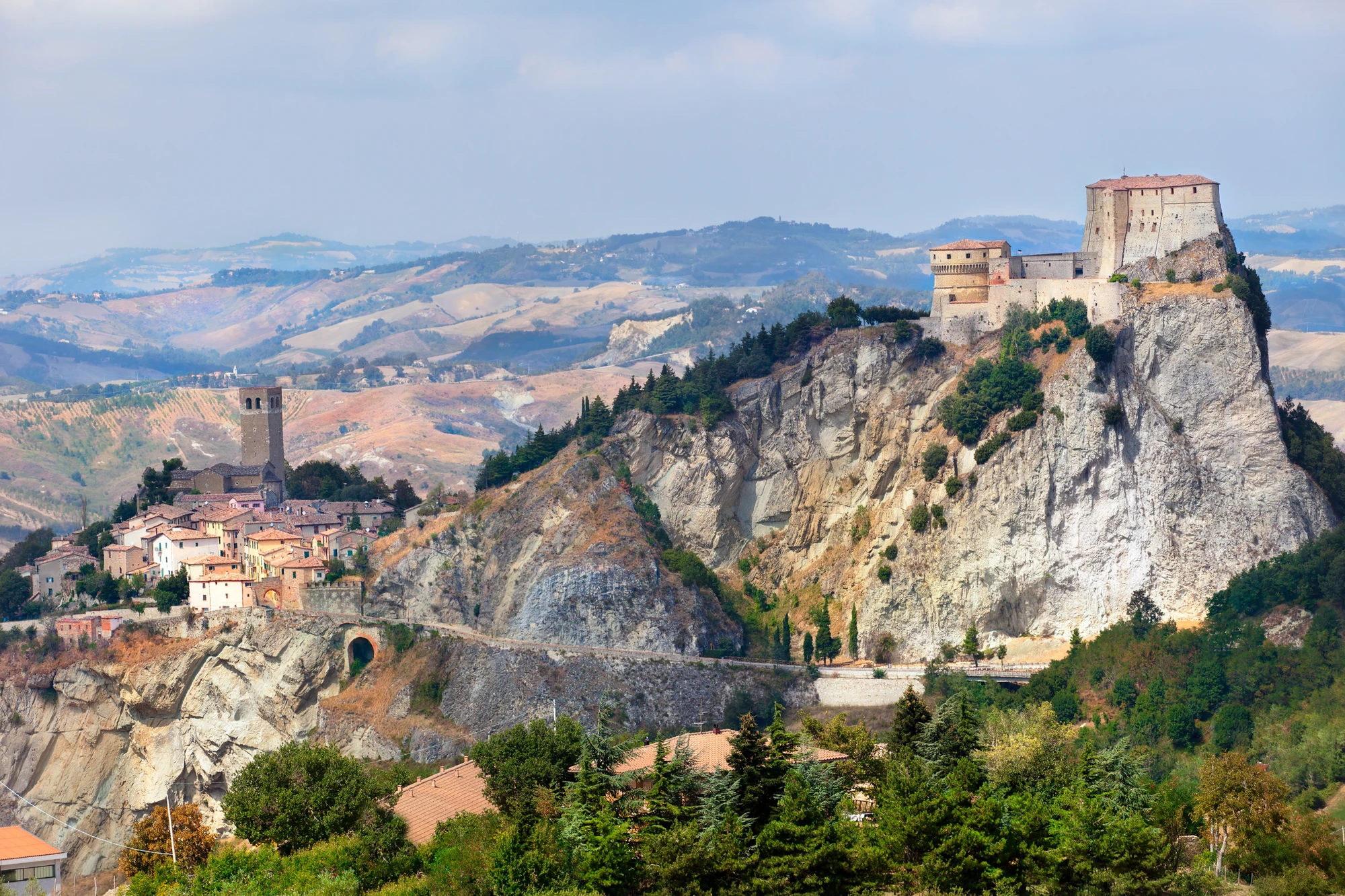Perched Between Stone and Sky: Exploring the Fortress of San Leo
A medieval stronghold where geology meets legend—why this hilltop fortress rewards both day trippers and hikers.
Photo by NickolayV
Shutterstock (ID: 85330447)
When you arrive in San Leo the town seems to have been set down on purpose—clustered stone houses, narrow alleys, and a single spine of basalt that lifts the fortress like a crown. The first time you walk the curve of the approach road, the fortress resolves itself from a silhouette into a structure of angles and shadow: buttresses catching the light, crenellations standing patient against wind, and a medieval keep that looks less built than grown from the rock itself. The air here has the particular dryness of hilltop towns; it carries the faint tang of sun-baked stone, chestnut trees, and the distant churn of agricultural life on the surrounding folds of countryside.
Trail Wisdom
Bring firm-soled shoes
Ramparts and interior stairways are uneven historic stone—sturdy soles reduce twists and slips.
Time your visit
Aim for early morning or late afternoon to avoid heat and bus crowds and to catch the best light.
Pack water and sun protection
There’s limited shade on the ramparts; carry 1–2 liters per person and a hat.
Include a downhill loop
Extend your visit with a 5–10 km loop on adjoining mule paths for varied scenery and fewer crowds.
Local Knowledge
Hidden Gems
- •The narrow Viale dei Cappuccini path below the fortress for quiet views and birdwatching
- •Small family-run enoteca in town serving regional Sangiovese and local pecorino cheese
Wildlife
Common buzzard, Red fox
Conservation Note
The site is managed as a cultural heritage landmark—stay on marked paths and support local conservation efforts by patronizing nearby businesses.
The fortress has medieval origins and was later used as a state prison; it’s also the place where Alessandro Cagliostro died in 1795.
Seasonal Guide
spring
Best for: wildflowers, cool hiking, quieter photography
Challenges: mud on shaded trails, unpredictable showers
Spring brings green hills and blooms—ideal for cooler, quieter walks—though sudden showers and muddy undergrowth are possible.
summer
Best for: longer daylight hours, extended ridge trails, evening dining
Challenges: high sun exposure, larger crowds, heat on exposed ramparts
Summer offers long days and warm evenings but plan for strong sun, carry extra water, and avoid midday heat on exposed stone.
fall
Best for: autumn colors, harvest events, crisper air for hiking
Challenges: shorter daylight, variable temperatures
Fall is a favorite for clear skies and harvest flavors—cool mornings and golden light make for excellent hiking and photos.
winter
Best for: quiet solitude, dramatic skies, low-season rates
Challenges: cold, potential frost on stone, reduced services and museum hours
Winter visits are quiet and atmospheric but expect cold wind on the ramparts and check opening times for attractions and eateries.
Photographer's Notes
What to Bring
Sturdy hiking shoesEssential
Protects ankles and provides traction on uneven stone and cobbled streets.
Hydration system or water bottle (1–2 L)Essential
Essential for exposed ramparts and summer hikes; water sources in town may be limited.
Sun hat and sunscreenEssential
Prevents sunburn on exposed fortifications and ridge trails.
Light daypack with layers
Holds water, a wind shell, and any purchases from local markets; useful for variable weather.
Common Questions
How long does a visit to the Fortress of San Leo take?
A basic circuit through the fortress and ramparts typically takes 60–90 minutes; add another 1–3 hours for extended ridge hikes or village loops.
Are there guided tours available?
Local guides and periodic museum guides are sometimes available—check the fortress' official schedule or ask at the tourist office in San Leo for current offerings.
Is the fortress accessible for strollers or wheelchairs?
No—historic stairways and uneven pathways make most areas of the fortress inaccessible; contact local authorities for limited-access options or viewpoints reachable from the town.
What is the best time of day to visit?
Early morning or late afternoon offers cooler temperatures, better light for photos, and fewer visitors; mid-afternoon can be busy in high season.
Can you hike from San Leo to other nearby villages?
Yes—old mule tracks and ridge paths connect to neighboring hamlets and valleys, providing half-day and full-day walking options of varying difficulty.
Are dogs allowed at the fortress?
Policies vary; many outdoor areas accept leashed dogs but some interior museum sections may not—check signage or ask local staff.
What to Pack
Sturdy shoes for uneven stone, 1–2 L water for exposed ramparts, sun protection for open parapets, light jacket for windy conditions.
Did You Know
Alessandro Cagliostro, a controversial 18th-century occultist, died while imprisoned in the Fortress of San Leo in 1795—a documented historical fact tied closely to the site's lore.
Quick Travel Tips
1) Park in the designated lots below the town to avoid narrow streets; 2) Check fortress opening hours in advance—seasonal changes apply; 3) Carry cash for small local purchases; 4) Combine your visit with a stop in a nearby enoteca for regional wines.
Local Flavor
San Leo sits on the cultural edge between Emilia-Romagna and Marche—expect simple, soulful food: freshly made piadina, aged pecorino, cured meats, and local Sangiovese or Verdicchio by the glass in small family-run enoteche.
Logistics Snapshot
Getting there: drive or regional bus to San Leo; parking available below town. Time needed: 1–3 hours for fortress plus optional half-day hikes. Facilities: small museum, toilets in town, seasonal cafes. Accessibility: uneven stone—limited wheelchair access.
Sustainability Note
Respect the fragile stonework by staying on designated paths, minimize single-use plastics, and support local businesses to help maintain cultural stewardship of the site.

